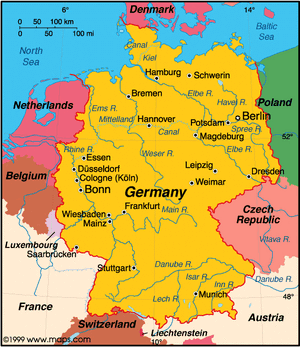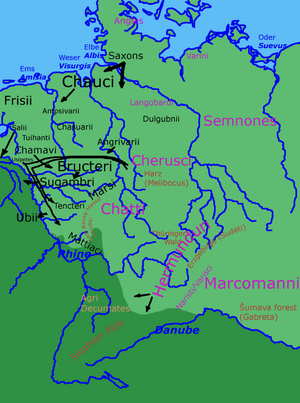Elbe
| Author:Laxman Burdak, IFS (R) |


Elbe (एल्व) is one of the major rivers of Central Europe.
Variants
Jat clans
Location
It rises in the Krkonoše Mountains of the northern Czech Republic before traversing much of Bohemia (Czech Republic), then Germany and flowing into the North Sea at Cuxhaven, 110 km northwest of Hamburg. Its total length is 1,094 kilometres.[1]
The Elbe's major tributaries include the rivers Vltava, Saale, Havel, Mulde, Schwarze Elster, and Ohře.[2]
Etymology
Albis or Albia are old medieval names for the river Elbe. First attested in Latin as Albis, the name Elbe means "river" or "river-bed" and is nothing more than the High German version of a word (albiz) found elsewhere in Germanic; cf. Old Norse river name Elfr, Swedish älv "river", Norwegian elv "river", Old English river name elf, and Middle Low German elve "river-bed".[3]
History
The Elbe was recorded by Ptolemy as Albis (Germanic for "river") in Germania Magna with its source in the Asciburgis mountains (Krkonoše, Riesengebirge or Giant Mountains), where the Germanic Vandalii lived.
The Elbe has long been an important delineator of European geography. The Romans knew the river as the Albis; however, they only attempted once to move the Eastern border of their empire forward from the Rhine to the Elbe, and this attempt failed in the Battle of the Teutoburg Forest in 9 AD, after which they never seriously tried again.
In the Middle Ages it formed the eastern limit of the Empire of Charlemagne. The river's navigable sections were also essential to the success of the Hanseatic League and much trade was carried on its waters.
Since the early 6th century the areas east of the rivers Elbe and Saale (which had been depopulated since the 4th century) were populated by Slavic tribes called the Polabian Slavs, to which Charlemagne granted sovereignty in 804. After Charlemagne's death in 814 Saxons invaded Slavic territories, exterminating the Slavs and successively destroying their states and culture, followed in 10th century by Gero and in the 12th century by the Wendish Crusade, annihilating also the catholic Duchy of Kopnik, a vasal to Poland, which eventually became Berlin—the German capital.
The Elbe delineated the western parts of Germany from the eastern so-called East Elbia, where soccage and serfdom were more strict and prevailed longer, than westwards of the river, and where feudal lords held bigger estates than in the west. Thus incumbents of huge land-holdings became characterised as East Elbian Junkers. The Northern German area north of the Lower Elbe used to be called North Albingia in the Middle Ages. When the four Lutheran church bodies there united in 1977 they chose the name North Elbian Evangelical Lutheran Church. Other, administrative units were named after the river Elbe, such as the Westphalian Elbe département (1807–1813) and the Lower Elbe département (1810), and the French département Bouches-de-l'Elbe (1811–1814).
In 1945, as World War II was drawing to a close, Nazi Germany was caught between the armies of the western Allies advancing from the west and the Soviet Union advancing from the east. On 25 April 1945, these two forces linked up near Torgau, on the Elbe. The event was marked as Elbe Day. After the war, the Elbe formed part of the border between East Germany and West Germany.
During the 1970s, the Soviet Union stated that Adolf Hitler's ashes had been scattered in the Elbe following disinterment from their original burial site.[4][5]
शिवि जनपद
ठाकुर देशराज [6] ने लिखा है....शिवि खानदान बहुत पुराना है। वैदिक काल से लेकर किसी न किसी रूप में सिकंदर के आक्रमण के समय तक इनका जिक्र पाया जाता है। पुराणों ने शिवि लोगों को उशीनर की संतानों में से बताया है। राजा ययाति के पुत्रों में यदु, पुरू, तुर्वषु, अनु और द्रुहयु आदि थे। उशीनर ने अनु खानदान के थे। पुराणों में इनकी जो वंशावली दी है वह इस प्रकार है:- 1. चंद्र 2. बुद्ध 3. पुरुरवा 4. आयु 5. नहुष 6. ययाति* 7. (ययाति के तीसरे पुत्र) अनु 8. सभानर 9. कालनर 10. सृजय 11. जन्मेजय 12.
* कुछ लोग राजा ययाति की राजधानी शाकंभरी अर्थात सांभर झील को मानते हैं जो कि इस समय जयपुर जोधपुर की सीमा पर है।
महाशील 13. महामना 14. महामना के दूसरे पुत्र उशीनर और 15. उशीनर के पुत्र शिवि। प्रसिद्ध दानी महाराज शिवि की कथाओं से सारी हिंदू जाति परिचित है।* ईसा से 326 वर्ष पूर्व जब विश्वविजेता सिकंदर का भारत पर आक्रमण हुआ था, उस समय शिवि लोग मल्लों के पड़ोस में बसे हुए थे। उस समय के इनके वैभव के संबंध में सिकंदर के साथियों ने लिखा है:- "कि इनके पास 40,000 तो पैदल सेना थी।" कुछ लोगों ने पंजाब के वर्तमान शेरकोट को इनकी राजधानी बताया है।†हम 3 स्थानों में इनके फैलने का वर्णन पाते हैं। आरंभ में तो यह जाति मानसरोवर के नीचे के हिस्से में आबाद थी। फिर यह उत्तर-पूर्व पंजाब में फैल गई। यही पंजाब के शिवि लोग राजपूताना में चित्तौड़ तक पहुंचते हैं। जहां इनकी मध्यमिका नगरी में राजधानी थी। यहां से इनके सिक्के भी प्राप्त हुए हैं जिन पर लिखा हुआ है- 'मज्झिम निकाय शिव जनपदस'
दूसरा समुदाय इनका तिब्बत को पार कर जाता है जो वहां शियूची नाम से प्रसिद्ध होता है। कई इतिहासकारों का कहना है कि कुशान लोग शियूची जाति की एक शाखा थे।
* शिवि जाति के कुछ प्रसिद्ध राजाओं का हाल परिशिष्ट में पढ़िए।
† यह शेरकोट पहले शिविपुर कहलाता था। कुछ लोग धवला नदी के किनारे के शिवप्रस्थ को शिवि लोगों की राजधानी मानते हैं।
महाराजा कनिष्क कुशान जाति के ही नरेश थे।
तीसरा दल इनका जाटों के अन्य दलों के साथ यूरोप में बढ़ जाता है। स्केंडिनेविया और जटलैंड दोनों ही में इनका जिक्र आता है। टसीटस, टोलमी, पिंकर्टन तीनों ही का कहना है कि-" जट्टलैंड में जट लोगों की 6 जातियां थी। जिनमें सुएवी, किम्ब्री हेमेन्द्री और कट्टी भी शामिल थीं, जो एल्व और वेजर नदियों के मुहाने तक फैल गईं थीं। वहां पर इन्होंने युद्ध के देवता के नाम पर इमर्नश्यूल नाम का स्तूप खड़ा किया था।” बौद्ध लोगों का कहना है कि भगवान बुद्ध तथागत ने पहले एक बार शिवि लोगों में भी जन्म लिया था। इन लोगों में हर-गौरी और पृथ्वी की पूजा प्रचलित थी। संघ के अधिपति को गणपति व गणेश कहते थे। इनकी जितनी भी छोटी-छोटी शाखाएं थी वह जाति राष्ट्र में सम्मिलित हो गई थी।
आरंभकाल में भारत में शिवि लोगों को दक्ष लोगों से भी भयंकर युद्ध करना पड़ा था। वीरभद्र नाम का इनका सेनापति दक्षनगर को विध्वंस करने के कारण ही प्रसिद्ध हुआ था। एक बार इन में गृह कलह भी हुआ था। जिसका समझौता इस प्रकार हुआ कि हस्ति शाखा के प्रमुख को पार्लियामेंट का इनको सर्वसम्मति से प्रधान चुनना पड़ा।* मालूम ऐसा होता है
* पुराणों में यह कथा बड़े गोलमोल के साथ वर्णन की गई है। हस्ति कबीले के लोग पीछे काबुल नदी के किनारे बसे थे। उनका हस्तीनगर आजकल न्यस्त व न्यस कहलाता है।
शिवि लोगों के संघ में जब कि वह जाति राष्ट्र के रूप में परिवर्तित हुआ सभी शिवि लोग शामिल हो गए थे। यह भी सही बात है कि नाग लोग भी शिव लोगों की ही शाखा के हैं। क्योंकि पूनिया जाट कहा करते हैं कि आदि जाट तो हम हैं और शिवजी की जटाओं से पैदा हुए हैं। इसमें कोई संदेह नहीं कि शिवि जाटों की संख्या एक समय बहुत थी। क्योंकि सिकंदर के समय में 40 हजार तो उनके पास पैदल सेना ही थी। यदि हम दस आदमियों पीछे भी एक सैनिक बना दे तो इस तरह वे 4 लाख होते हैं और जबकि उनके दो बड़े-बड़े समूह चीन और यूरोप की ओर चले गए थे। यदि समस्त शिवि जाटों की अंदाज से ही गिनती करें तो वह 10 लाख के करीब साबित हो सकते हैं।
शायद कुछ लोग कहें कि 'यह माना कि शिवि एक महान और संपन्न जाति भारत में थी किंतु यह कैसे माना जाए किसी भी शिवि लोग जाट थे'? इसका उत्तर प्रमाण और दंतकथा दोनों के आधार पर हम देते हैं।
(1) पहली दंतकथा तो यह है कि जाट शिव की जटाओं में से हुए हैं। अर्थात शिवि लोग जाट थे।
(2) जाट शिव के गणों में से हैं अर्थात गणतंत्री शिवि जाट थे।
(3) जाट का मुख्य शिव ने बनाया, इसके वास्तविक माने यह है कि 'जाट-राष्ट्रों' में प्रमुख शिवि हैं।
यह इन दंतकथाओं के हमारे किए अर्थ न माने जाएं, तब भी इतना तो इन दंतकथाओं के आधार पर स्वीकार करना ही पड़ेगा कि जाट और शिवि लोगों का कोई
न कोई संबंध तो है ही। हम कहते हैं कि संबंध यही है कि शिवि लोग जाट थे। इसके लिए प्रमाण भी लीजिए। "ट्राइब्स एंड कास्ट्स ऑफ द नॉर्थ वेस्टर्न प्रोविन्सेज एंड अवध" नामक पुस्तक में मिस्टर डबल्यू क्रुक साहब लिखते हैं:
The Jats of the south-eastern provinces divide them selves into two sections - Shivgotri or of the family of Shiva and Kashyapagotri.
अर्थात् - दक्षिणी पूर्वी प्रान्तों के जाट अपने को दो भागों में विभक्त करते हैं - शिवगोत्री या शिव के वंशज और कश्यप गोत्री ।
इसी तरह की बात कर्नल टॉड भी प्रसिद्ध इतिहासकार टसीटस (Tacitus) के हवाले से लिखते हैं:- "स्कंदनाभ देश में जट नामक एक महापराक्रमी जाति निवास करती थी। इस जाति के वंश की बहुत सी शाखाएं थी। उन शाखाओं में शैव और शिवि लोगों की विशेष प्रतिष्ठा थी। "
हिंदुओं के प्राचीन ग्रंथकारों ने शिवि लोगों को शैवल और शैव्य कर के भी लिखा है। इनमें कई सरदार बड़े प्रतापी हुए हैं। उनके जीवन पर परिशिष्ट भाग में थोड़ा सा प्रकाश डालेंगे।
सेमनोनेस
सेमोन एक सुएवी लोगों की जर्मनिक जनजाति थी जो पहली सदी में एल्बे और ओडर नदी के बीच बसे हुये थे। पहली सदी में उनका वर्णन टैसिटस ने जर्मनिया में किया है। सेमनोनेस के राजा मासी और उसके पुजारी गाना कैसियस डियो द्वारा उल्लिखित हैं। एक पवित्र उपवन में उन्होंने परम देव की पूजा की। एड्डा की एक कविता हेल्गकविआ हुनडिंग्सबाना II में एक उपवन का उल्लेख है। तीसरी शताब्दी में, सेम्नोन्स दक्षिण की ओर खिसक गये और अंत में आलमनी लोगों का हिस्सा बन गया। ऑग्सबर्ग में एक एक रोमन स्मारक की वेदी पर 260 ई. का एक शिलालेख मिला जिसमें कहा गया है कि सेमनोनेस जुथुंगी भी कहलाते थे। [7]
External links
References
- ↑ "Elbe River basin". International Commission for the Protection of the Elbe River
- ↑ "Elbe River basin". International Commission for the Protection of the Elbe River
- ↑ Orel, Vladimir. A Handbook of Germanic Etymology. Leiden, Netherlands: Brill, 2003: 13
- ↑ Hans Meissner, Magda Goebbels, First Lady of the Third Reich, 260–277
- ↑ Maxim Tkachenko (11 December 2009). "Official: KGB chief ordered Hitler's remains destroyed". CNN
- ↑ Jat Itihas (Utpatti Aur Gaurav Khand)/Pancham Parichhed, pp.91-95
- ↑ Helmut Castritius: Semnonen. In: Reallexikon der germanischen Altertumskunde, vol. 28 (2005), p. 156
Back to Rivers

